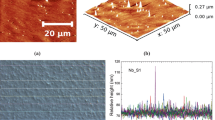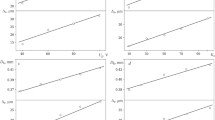Abstract
A complete cycle of manufacturing all parts of superconducting niobium cavities which comprise two half-cells, two drift tubes, and two flanges each has been developed. The cavity half-cells are manufactured by hydropercussion punching, which has a number of advantages over the instrumental stamping technique. For the first time, the diagram of formability of ultrapure niobium has been experimentally obtained for hydropercussion punching and the key parameters of the process have been determined that ensure complete deep-drawing of workpieces, viz., the value of the limit drawing ratio of ultrapure niobium that is 1.92 at a specific impact energy of 0.42 MJ/m2. The deviations of the half-cell dimensions from the rated values do not exceed 0.1 mm. Production tools required for all manufacturing steps have been created. The parameters of machining of the niobium cavity parts prior to welding have been experimentally established.
Similar content being viewed by others
References
W. Singer, J. Iversen, and A. Schmidt, “Technical specifications for the series mechanical fabrication of super-conducting 1.3 GHz cavities for the european XFEL,” Rev. B (2009).
W. Singer, X. Singer, I. Jelezov, and P. Kneisel, “"Hydroforming of elliptical cavities”," Phys. Rev. ST Accel. Beams 18, 022001 (2015).
V. S. Petrakovskii and A. Yu. Zhuravskii, “Evaluation of formability of ultra-pure niobium at hydro shock loading,” in Proceedings of the 8th International Scientific-Technical Conference on Modern Methods and Technologies of the Creation and Processing of Materials (Minsk, 2013), Vol. 3, pp. 147–156.
V. S. Petrakovskii, “Evaluation of formability of sheet metal in hydropercussion drawing, in Pulse Methods of Material Processing (Nauka Tekhnika, Minsk, 1979), pp. 77–81 [in Russian].
V. S. Petrakovskii, G. N. Zdor, and A. Yu. Zhuravskii, “Engineering calculation method of sheet material pulse drawing,” in Proceedings of the 6th International Scientific-Technical Conference on Modern Methods and Technologies of the Creation and Processing of Materials (Minsk, 2011), Vol. 3, pp. 126–130.
V. P. Romanovskii, Handbook of Cold Stamping (Mashinostroenie, Leningrad, 1979) [in Russian].
M. E. Zubtsov, Sheet Stamping (Mashgiz, Moscow, Leningrad, 1958) [in Russian].
Author information
Authors and Affiliations
Corresponding author
Additional information
Original Russian Text © N.S. Azaryan, G.D. Shirkov, A.Yu. Zhurauski, V.S. Petrakovski, M.A. Batouritski, 2016, published in Pis’ma v Zhurnal Fizika Elementarnykh Chastits i Atomnogo Yadra, 2016.
Rights and permissions
About this article
Cite this article
Azaryan, N.S., Shirkov, G.D., Zhurauski, A.Y. et al. Manufacture of superconducting niobium cavity parts by hydropercussion punching. Phys. Part. Nuclei Lett. 13, 218–223 (2016). https://doi.org/10.1134/S1547477116020023
Received:
Published:
Issue Date:
DOI: https://doi.org/10.1134/S1547477116020023




